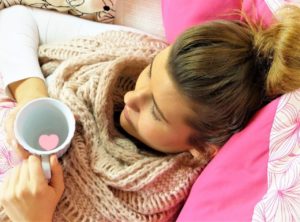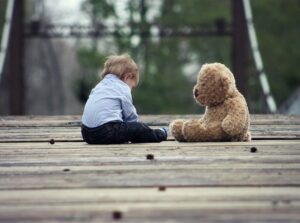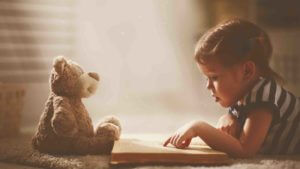Labial synechiae can occur once or recurrently. In any case, labia adhesion is a condition that can be very unpleasant for little girls. How to recognize if one labia is stuck together with the other, which symptoms indicate the disease, and tips for treatment can be read here!
Labial synechiae or vulvar synechiae is not an uncommon condition in little girls. Mostly the so-called labial adhesion is noticed on the changing table at home, in some cases, the pediatrician makes the diagnosis of labia synechiae. In this article, we clarify the most important questions on the subject and give tips on how labia adhesion can be treated.
Table of contents
What Is Labial Synechiae?
Labial synechiae refer to adhesions (“synechiae”) of the labia minora or inner labiae (“labiae”). Girls from two to four years old are most commonly affected, but menopausal women can also suffer from labial synechiae. If your child has developed labial stenosis, you will recognize it by a completely or partially closed vaginal opening. If your girl is still wearing diapers, a labia adhesion is usually quickly noticed: The labia minora are stuck together, which is indicated by a fine white line at this point. However, if your daughter already goes to the toilet on her own, you may not notice such a condition right away. Usually, after urination, some urine remains in the vagina and then gradually drips out. If you have the feeling that your child is suddenly no longer dry, a labial synechiae may be the reason.
How Does A Labial Synechiae Develop?
A labial synechiae is not a malformation of the sexual organs, as some parents think. Rather, it is a condition triggered by hormone deficiency. During the hormonal rest period, before puberty or during menopause, the ovaries do not produce estrogens. These hormones ensure, among other things, that the outer and inner labia are well supplied with blood. If the influence of estrogens is absent, the skin of each labia is more sensitive and less protected against injuries and inflammations.
However, not every girl before puberty and every woman in monopause develops labial synechiae. So what factors cause one labium to stick to the other? Often it is either excessive, but also inadequate hygiene that triggers labial synechiae. If the skin is irritated too much by washcloths, wet wipes, soap and sitz baths, micro-injuries often occur in which a bacterial infection can spread. The already delicate skin in the intimate area becomes irritated and has no barrier against germs from the outside. Adhesions can form in the injured areas of one labia or both labia.
Poor or incorrect toilet hygiene can also cause your child’s labia minora to stick together. For example, if you hardly wash or do not clean properly after going to the toilet, germs can settle more easily and stick one labia to the other. A worm disease can also result in labial synechiae.
How Dangerous Is Labial Synechiae?
Labial adhesion is not a life-threatening condition. However, if left untreated, it can cause other health problems. Depending on how severely the vaginal entrance is closed, urine can collect inside the vagina and subsequently cause an infection there, as well as of the urinary tract and, in the worst case, of the kidneys. If the edges of one labia have stuck together with those of another labia, hygiene can also be compromised in the following: As a rule, no water penetrates through the adhesion. Even when bathing, the vagina is not cleaned.
A labial synechiae does not dissolve by itself, but treating it on your own and without guidance at home is not recommended. As soon as you notice a sticking at the vaginal entrance of your child, it is advisable to go to the doctor.
What Are The Signs Of Labial Synechiae?
Even before you yourself or a pediatrician can specifically see labial synechiae by the adhesion of one labium to the other, there are several other symptoms that may indicate the condition. Among other things, redness of the vulva, which in many cases is also recurrent (recurring), urinary dribbling, inflammation of the vulva – also recurrent – can indicate labial synechiae. Delayed or even painful urination can also be the consequences of labial adhesions.
Whether you notice one or more of these symptoms in your child also depends on her age. Little girls who cannot yet speak or go to the toilet on their own will not be able to express their symptoms accurately. However, you may notice that your child does not feel well or has pain when urinating. It is also conceivable that urine is withheld as a result because there is fear of the pain. Vaginitis can also make itself felt through itching. If the girl repeatedly touches her pubic area to scratch herself, a bacterial infection may be present here, triggered by adhesion of the labia.
How Is Labial Synechiae Treated?
As already mentioned: A labial synechiae is not a case for the medicine cabinet, like a cold in a child. Under no circumstances should you try to detach one stuck labia from the other yourself. This could be very painful for your child and cause trauma! From a physical point of view, forcibly opening the labial synechia can result in it becoming recurrent or in scarring on the labia. Labial synechiae, recurrent or unique, is always a case for the pediatrician and, in older girls, for the gynecologist.
Inner labia that are stuck together are usually successfully resolved with one of the following treatment methods.
Treatment With Estrogen Ointment
Application of an ointment containing estrogen is recommended as a therapy in many cases. Over a period of one month, a pea-sized amount of the low-dose preparation is applied to the stuck area. This is recommended after going to the toilet and cleaning, as well as with a cotton swab, so as not to bring any more germs into the already irritated vaginal entrance. You should be particularly careful here with children who are already in pain.
In most cases, the estrogen it contains quickly dissolves the labial synechiae, and the vaginal area can be gently cleaned afterwards.
Treatment With Cortisone Ointment
If the ointment containing estrogen does not help and the symptoms are recurrent or the medication shows side effects, a preparation containing cortisone is often prescribed. Just like estrogen ointment, cortisone ointment is applied in small amounts to the adhesions. The doctor decides on the dosage and frequency of application.
How To Counteract Recurrent Labial Synechiae?
To prevent labial adhesions from becoming recurrent and coming back again and again, you can take to heart some tips on toilet and washing hygiene with your child. These are quite easy to implement and can break the vicious cycle of recurrent labial synechiae.
Tip 1: Use A Toilet Seat
If your child already goes to the toilet independently, a toilet seat is recommended until he or she no longer has to hold onto the normal toilet seat to urinate. This can prevent urine from collecting in the vagina. Children can also dab themselves with toilet paper more easily in the comfortable sitting position.
Tip 2: Wipe Properly
After defecation, the direction in which the bottom is wiped is important. The correct direction would always be from front to back, so that no fecal germs get into the vagina. Used paper should be thrown directly into the toilet bowl and not folded up again for further use. Even if your child already wipes himself after going to the toilet, you can check from time to time whether he has internalized and adheres to these rules.
Tip 3: Washing Hands
Every child knows this, but it is not always remembered that hands should be washed after going to the toilet.
Tip 4: Clean The Vagina Gently
Vagina and outer as well as inner labia do not require aggressive cleaning. In the case of or after adhesions, recurrent or not, the outside can be cleaned with clear water. For this purpose, use either the hands or a washcloth, which is changed daily. If the skin around a labia or larger area is irritated, one bath per week is sufficient to prevent it from drying out and forming the breeding ground for labial synechiae, which is recurrent. For care, unscented oil can be added to the bath water.
For the care of vaginal entrance and irritated areas of the labia, a moisturizing or greasy cream can be used. It is best to talk to your doctor about whether and which care measures should be taken in addition to daily cleansing.









